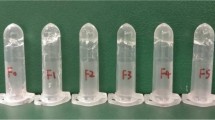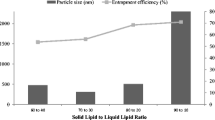Abstract
Liposomes have emerged as pivotal entities in the field of therapeutics, particularly in the domain of protein and vaccine administration. Hence, the development of novel liposomal formulations has garnered considerable interest. Liposomal delivery systems are considered advantageous as medication carriers, especially in the field of dermatology, owing to their moisturizing and restorative characteristics. Nevertheless, a significant drawback in the utilization of liposomes in topical applications is the inherent fluidity of the formulation, which might result in leakage following delivery to the skin surface. The use of liposomes inside the gel matrix, while maintaining the integrity of the vesicles, presents a potentially appealing method for topical administration. The primary objective of this work is to develop a liposomal-loaded gel formulation and assess its in vitro release characteristics as well as its rheological profile, including viscoelastic properties and flow behaviour. This study incorporated two different types of drugs, namely hydrophilic (specifically diphenhydramine hydrochloride) and hydrophobic (namely curcumin), inside its formulations. A liposome, composed of a long alkyl chain lipid such as DPPC with a chain length of 16, was synthesized using the thin film hydration process and subsequently integrated into a carbopol gel. It is noteworthy that the introduction of diphenhydramine hydrochloride (DPH) resulted in a substantial decrease in the elastic modulus and cohesiveness of the liposomal gel. Conversely, the incorporation of curcumin-loaded liposomal gel led to an increase in critical strain and cohesiveness when compared to the plain liposomal gel. In contrast, the liposomal gel containing DPH and curcumin demonstrated a reduced release rate compared to the plain liposomal gel, spanning a duration of 48 h. The in vitro release studies offer the potential for the utilization of liposomal gels as a sustained delivery system.










Similar content being viewed by others
Data availability
The data is available within the article.
References
Liu P, Chen G, Zhang J (2022) A review of liposomes as a drug delivery system: current status of approved products, regulatory environments, and future perspectives. Molecules 27:1372. https://doi.org/10.3390/molecules27041372
Gomaa AI, Martinent C, Hammami R, Fliss I, Subirade M (2017) Dual coating of liposomes as encapsulating matrix of antimicrobial peptides: development and characterization. Front Chem 5(2017):103. https://doi.org/10.3389/fchem.2017.00103
Nsairat H, Khater D, Sayed U, Odeh F, Al Bawab A, Alshaer W (2022) Liposomes: structure, composition, types, and clinical applications. Heliyon 8:e09394. https://doi.org/10.1016/j.heliyon.2022.e09394
Lee MK (2020) Liposomes for enhanced bioavailability of water-insoluble drugs: in vivo evidence and recent approaches. Pharmaceutics 12:264. https://doi.org/10.3390/pharmaceutics12030264
Allahou LW, Madani SY, Seifalian A (2021) Investigating the application of liposomes as drug delivery systems for the diagnosis and treatment of cancer. Int J Biomater. https://doi.org/10.1155/2021/3041969
Cao Y, Dong X, Chen X (2022) Polymer-modified liposomes for drug delivery: from fundamentals to applications. Pharmaceutics 14:778. https://doi.org/10.3390/pharmaceutics14040778
Nakhaei P, Margiana P, Bokov DO, Abdelbasset WK, Jadidi Kouhbanani MA, Varma RS, Beheshtkhoo N (2021) Liposomes: structure, biomedical applications, and stability parameters with emphasis on cholesterol. Front Bioeng Biotechnol. https://doi.org/10.3389/fbioe.2021.705886
Lombardo D, Kiselev MA (2022) Methods of liposomes preparation: formation and control factors of versatile nanocarriers for biomedical and nanomedicine application. Pharmaceutics 14:543. https://doi.org/10.3390/pharmaceutics14030543
Le NTT, Cao VD, Nguyen TNQ, Le TTH, Tran TT, Hoang TT (2019) Soy lecithin-derived liposomal delivery systems: surface modification and current applications. Int J Mol Sci 20:4706. https://doi.org/10.3390/ijms20194706
Gibis M, Zeeb B, Weiss J (2014) Formation, characterization, and stability of encapsulated hibiscus extract in multilayered liposomes. Food Hydrocoll 38:28–39. https://doi.org/10.1016/j.foodhyd.2013.11.014
Uchegbu IF, Schätzlein AG, Cheng WP, Lalatsa A (2013) Fundamentals of pharmaceutical nanoscience. Springer, New York. https://doi.org/10.1007/978-1-4614-9164-4
Juszkiewicz K, Sikorski AF, Czogalla A (2020) Building blocks to design liposomal delivery systems. Int J Mol Sci 21:9559. https://doi.org/10.3390/ijms21249559
Tomnikova A, Orgonikova A, Krizek T (2022) Liposomes: preparation and characterization with a special focus on the application of capillary electrophoresis. Monatsh Chem 153:687–695. https://doi.org/10.1007/s00706-022-02966-0
Mou Y, Zhang P, Lai WF, Zhang D (2022) Design and applications of liposome-in-gel as carriers for cancer therapy. Drug Deliv 29:3245–3255. https://doi.org/10.1080/10717544.2022.2139021
Ruiz-Rubio L, Alonso ML, Pérez-Álvarez L, Alonso RM, Vilas JL, Khutoryanskiy VV (2018) Formulation of Carbopol®/poly(2-ethyl-2-oxazoline) mucoadhesive tablets for buccal delivery of hydrocortisone. Polymers 10:175. https://doi.org/10.3390/polym10020175
Scomoroscenco C, Teodorescu M, Raducan A, Stan M, Voicu SN, Trica B, Cinteza LO (2021) Novel gel microemulsion as topical drug delivery system for curcumin in dermatocosmetics. Pharmaceutics 13:505. https://doi.org/10.3390/pharmaceutics13040505
Maja L, Željko K, Mateja P (2020) Sustainable technologies for liposome preparation. J Supercrit Fluids 165:104984. https://doi.org/10.1016/j.supflu.2020.104984
Khan AA, Allemailem KS, Almatroodi SA, Almatroudi A, Rahmani AH (2020) Recent strategies towards the surface modification of liposomes: an innovative approach for different clinical applications. 3 Biotech 10:1–15. https://doi.org/10.1007/s13205-020-2144-3
Park SN, Jo NR, Jeon SH (2014) Chitosan-coated liposomes for enhanced skin permeation of resveratrol. J Ind Eng Chem 20:1481–1485. https://doi.org/10.1016/j.jiec.2013.07.035
Zhou W, Liu W, Zou L, Liu W, Liu C, Liang R, Chen J (2014) Storage stability and skin permeation of vitamin C liposomes improved by pectin coating. Colloids Surf B Biointerfaces 117:330–337. https://doi.org/10.1016/j.colsurfb.2014.02.036
Agarwal R, Iezhitsa I, Agarwal P, Abdul Nasir NA, Razali N, Alyautdin R, Ismail NM (2016) Liposomes in topical ophthalmic drug delivery: an update. Drug Deliv 23:1075–1091. https://doi.org/10.3109/10717544.2014.943336
Aziz SN, Badawy AA, Nessem DI, Abd El Malak NS (2020) Promising nanoparticulate system for topical delivery of diphenhydramine hydrochloride: in-vitro and in-vivo evaluation. J Drug Deliv Sci Technol 55:101454. https://doi.org/10.1016/j.jddst.2019.101454
Jeengar MK, Rompicharla SVK, Shrivastava S, Chella N, Shastri NR, Naidu VGM, Sistla R (2016) Emu oil based nano-emulgel for topical delivery of curcumin. Int J Pharm 506:222–236. https://doi.org/10.1016/j.ijpharm.2016.04.052
Dei Cas M, Ghidoni R (2019) Dietary curcumin: correlation between bioavailability and health potential. Nutrients 11:2147. https://doi.org/10.3390/nu11092147
Yousef SA, Mohammed YH, Namjoshi S, Grice JE, Benson HAE, Sakran W, Roberts MS (2019) Mechanistic evaluation of enhanced curcumin delivery through human skin in vitro from optimised nanoemulsion formulations fabricated with different penetration enhancers. Pharmaceutics 11:639. https://doi.org/10.3390/pharmaceutics11120639
Wei Tan H, Misni M (2014) Effect of chitosan-modified fatty acid liposomes on the rheological properties of the carbohydrate-based gel. Appl Rheol 24:16–24. https://doi.org/10.3933/applrheol-24-34839
Heggset EB, Strand BL, Sundby KW, Simon S, Chinga-Carrasco G, Syverud K (2019) Viscoelastic properties of nanocellulose based inks for 3D printing and mechanical properties of CNF/alginate biocomposite gels. Cellulose 26:581–595. https://doi.org/10.1007/s10570-018-2142-3
Rudraraju VS, Wyandt CM (2005) Rheology of microcrystalline cellulose and sodiumcarboxymethyl cellulose hydrogels using a controlled stress rheometer: part II. Int J Pharm 292:63–73. https://doi.org/10.1016/j.ijpharm.2004.10.012
Huang M, Liang C, Tan C, Huang S, Ying R, Wang Y, Wang Z, Zhang Y (2019) Liposome co-encapsulation as a strategy for the delivery of curcumin and resveratrol. Food Funct 10:6447–6458. https://doi.org/10.1039/c9fo01338e
Ismail SH, Hamdy A, Ismail TA, Mahboub HH, W. H., Mahmoud, W. M. Daoush, (2021) Synthesis and characterization of antibacterial Carbopol/ZnO hybrid nanoparticles gel. Crystals 11:1092. https://doi.org/10.3390/cryst11091092
Pramod K, Shanavas S, Ansari SH, Ali J (2015) Eugenol significantly affects the flow of its nanodroplet gel. Int J Pharm Investig 5:200–204. https://doi.org/10.4103/2230-973X.167669
Dejeu IL, Vicaș LG, Vlaia LL, Jurca T, Mureșan ME, Pallag A, Coneac GH, Olariu IV, Muț AM, Bodea AS, Dejeu GE, Maghiar OA, Marian E (2022) Study for evaluation of hydrogels after the incorporation of liposomes embedded with caffeic acid. Pharmaceuticals 15:175. https://doi.org/10.3390/ph15020175
Mady O (2014) Studying the effect of dispersed drug crystal in the organic phase on the encapsulation by solvent evaporation technique; (4) dependent models as tools for studying the drug release. World J Pharm Sci 549–564
Wu WD, Liu W, Selomulya C, Chen XD (2011) On spray drying of uniform silica-based microencapsulates for controlled release. Soft Matter 7:11416–11424. https://doi.org/10.1039/C1SM05879G
Acknowledgements
A generous gift of Carbopol 934 from Corel Pharma Chem, Ahmedabad, India is acknowledged. We are also grateful for the support of the Department of Chemistry, the University of Malaya, and National Gifted Center, National University of Malaysia for supporting this work.
Author information
Authors and Affiliations
Corresponding author
Ethics declarations
Conflict of interest
The authors declare that they have no known competing financial interests or personal relationships that could have appeared to influence the work reported in this paper.
Additional information
Publisher's Note
Springer Nature remains neutral with regard to jurisdictional claims in published maps and institutional affiliations.
Rights and permissions
Springer Nature or its licensor (e.g. a society or other partner) holds exclusive rights to this article under a publishing agreement with the author(s) or other rightsholder(s); author self-archiving of the accepted manuscript version of this article is solely governed by the terms of such publishing agreement and applicable law.
About this article
Cite this article
Menon, P., Teo, Y.Y. & Misran, M. Development and evaluation of dipalmitoyl phosphatidylcholine (DPPC) liposomal gel: rheology and in vitro drug release properties. Korea-Aust. Rheol. J. 36, 45–54 (2024). https://doi.org/10.1007/s13367-023-00082-x
Received:
Revised:
Accepted:
Published:
Issue Date:
DOI: https://doi.org/10.1007/s13367-023-00082-x




